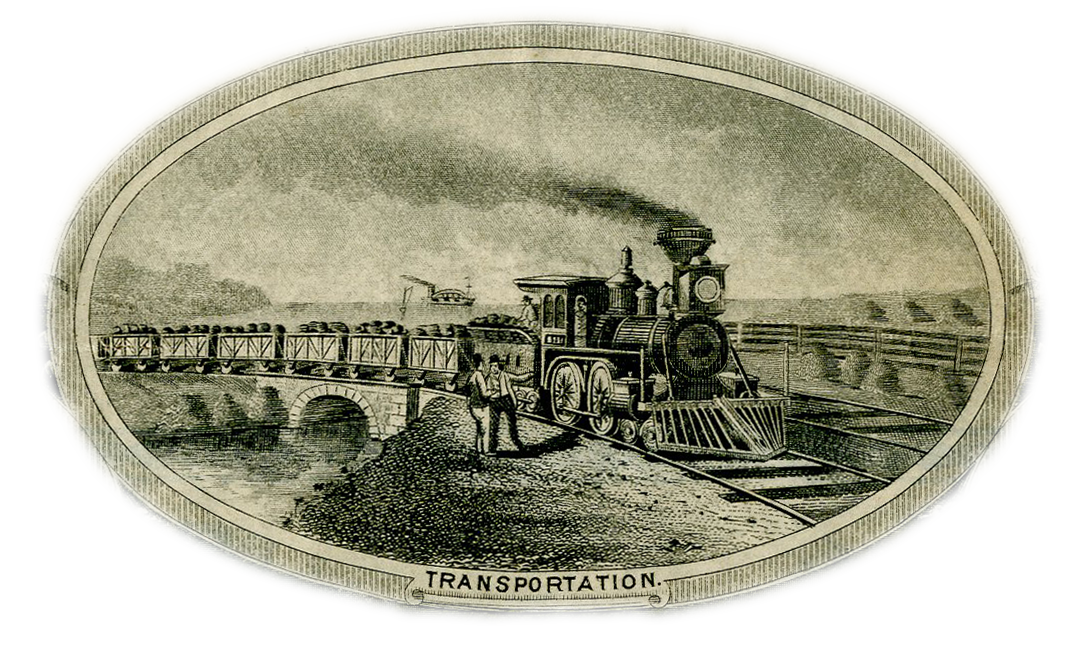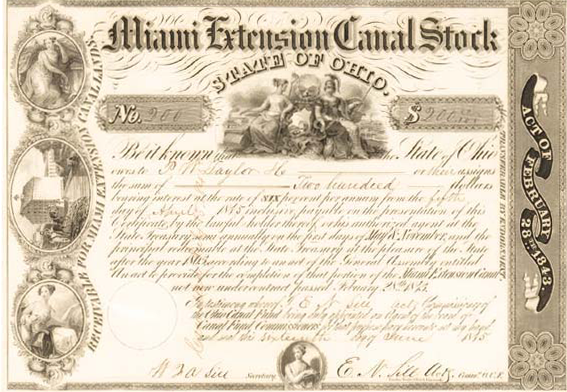

Collecting by topic has always been appealing to collectors. This article focused on “Canals” which played an important part of the industrialization development our country. Canals were a particularly important part of our infrastructure especially from the 1820’s to 1850’s. Published in our Spring newsletter of 1981.
Historical Notes
Canals represented an attempt to cope with the transportation problems of a rapidly growing nation with boundaries, which were far-flung. Early in the nineteenth century, interest in canals began to surface in the United States. However, it was not until the completion of New York State`s celebrated Erie Canal in 1825 that the canal “boom” got underway in earnest. For nearly two decades following the Erie`s completion, state after state appropriated funds for canal projects. These huge construction expenditures were typically underwritten by the issuance of interest bearing bonds.
Ironically, just as many major canal projects were completed in the late 1830's and early 1840`s, the demise of the canal era was a foregone conclusion. Railroads had already come of age, and had been seized upon as a much more practical, less expensive, and flexible means of transportation. Canals` halcyon days of the l840's were immediately supplanted by several decades of sharp decline reflected in falling usage and decreased revenues. By 1870, canals had largely been abandoned as a means of transportation.
MIAMI EXTENSION CANAL
The Miami Extension Canal was one of the first two canal projects authorized by the Ohio State Legislature in 1825. Governor DeWitt Clinton of New York State, home of the famous Erie Canal (and one of the few which ever made any money), was on hand for the ceremonial groundbreaking activities at Middleton, Ohio, on July 21, 1825. The Miami Canal, which ran sixty-six miles between Cincinnati and Dayton, was completed in early 1829 at a cost, which exceeded $900.000.
Even as construction proceeded, plans were being formulated for an addition to the Miami Canal. Early in 1833, the first seventeen miles of the Miami Extension Canal, which would ultimately stretch northward from Dayton 125 miles to intersect the Wabash & Erie Canal at Defiance, were placed under contract, and construction began.
The Miami Extension Canal, one of the largest internal improvement projects in Ohio at the time, nearly proved to be an engineering boondoggle. Anticipating an unusually heavy volume of barge traffic for the extension, planners opted to increase the standard forty-foot width to fifty feet, and increase the standard depth from four to five feet. This sizeable increase in the measurements of the canal required a significantly greater volume of water than other canals to insure continuous, efficient operation. Despite the construction of two gigantic reservoirs to supply the extra water needed to maintain the canal's volume of water, these were still insufficient to guarantee uninterrupted operation. Moreover, faulty lock design caused problems due to their inadequate size. Despite these major difficulties, the entire canal was completed and opened to traffic in 1845, only to be closed for extensive repairs a few weeks later.
OHIO CANAL
The Ohio Canal was a companion project to the Miami Canal (and later Miami Extension Canal), both of which were begun in 1825. This huge construction project had as its ultimate and ambitious goal nothing less than a linkage between Lake Erie (and the Erie Canal) at its northern terminus, and the Ohio River at its southern "port."
In spite of the enormity of the project, which cost a staggering $5.000.000 to complete, the Ohio Canal was finished and operating by October 1832. Even more revealing than the cost alone were the physical dimensions of the project. Running in a northeasterly direction from Portsmouth to Cleveland, the Ohio Canal was 307 miles long, forty feet wide, four feet deep, with 152 locks.
The canal served as a temporary economic stimulus to Ohio as it opened up interior state markets to trade both within and without of state boundaries. Farmers no longer were without cash markets or even the basic means of transportation to carry their crops to market. For example, the canal's completion near Akron sparked a boom in wheat farming in that area. Wheat had brought only twenty to thirty cents per bushel prior to the canal's opening, but that figure jumped to seventy-five cents per bushel by 1833.
Despite this type of short-lived economic shot-in-the arm, the Ohio Canal, like all canals, enjoyed only a very brief heyday as railroads soon spread across the country.

Originally Published and Printed by G.Labarre, The LaBarre Newsletter, Issue 2, Spring 1981



























Ebay ID: labarre_galleries